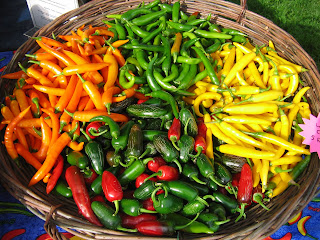The Rise of the Lazy Locavore - WSJ.com
There could hardly be a loftier culinary class than that of the locavore, a movement whose members eschew food grown outside a 100-mile radius of their homes. With copious outputs of money and labor, locavores earn bragging rights (we put up 50 jars of beets!), complaining rights (we went without wheat all winter!) and the right to believe they are doing their part to save the planet (we support local farms by paying $10 a pound for cherries!).
But James Lucal in Seattle has them all beat. He not only brings home the local produce, he got a local to grow it for him directly outside his home. And yet he spent almost nothing for this luxury, and lifted not so much as a trowel to make it happen.
Welcome to "urban sharecropping," the hippest, most hardcore new way to eat local. In the latest twist in the farm-to-table movement, homeowners who lack free time or gardening skills are teaming up with would-be farmers who lack backyards. Around the country, a new crop of match-makers are helping the two groups find each other and make arrangements that enable both sides to share resources and grow their own food.
Mr. Lucal's tenant farmer Michaelynn Ryan is a mother of two and homeowner in the charming Seattle neighborhood of Wallingford. Though Ms. Ryan is a certified master gardener, the yard of her Craftsman house isn't up to farming—it's too small and shaded, Ms. Ryan says. So, the summer before last, she posted a want ad for a garden plot on Urban Garden Share, a website started by a professional gardener as a good-karma producing hobby.
That's how Ms. Ryan found Mr. Lucal, a builder who had terraced a steep slope next to his house, but discovered through frustrating failure he lacked the patience and expertise to make it bloom. Finding they lived within five minutes of each other, they agreed Ms. Ryan would farm the lot and Mr. Lucal would harvest his family's supply.
The season was a bounty of candy-sweet strawberries and tart, pie-ready rhubarb. Carrots emerged from the ground in a rainbow of orange, yellow and red hues, and crookneck squash grew giant-sized under fuzzy elephant-ear leaves. The juicy tomatillos and pungent cilantro were so abundant, Ms. Ryan made 24 jars of Mexican salsa verde. Her 3-year-old daughter Fiona ran between the raised beds, popping brilliant green sugar snap peas into her mouth.
But even the most utopian and cost-saving of food systems has its price to pay. Ms. Ryan, like generations of tenant farmers before her, had to hand over half her hard-won crop to Mr. Lucal. Some in the movement might label him a "lazy locavore," a new designation indicating one whose diet is beyond reproach, but who has found a way around the hard work. Mr. Lucal says he's more "ignorant locavore" than lazy: After all, he watered.
The beauty of urban sharecropping is how neatly it halves the commitment required by local eating, providing honored roles for both the landless and the lazy. Homeowners look out on to their backyards—in many cases, under-used, water-sucking lawns or weed-chocked lots—and see lovely kitchen gardens that can often feed not only their own families but several neighbors', too. The farmer drops by, weeds, sows or harvests, then often leaves a basket of perfectly ripe produce on the owner's back porch. Gardeners get to skirt the notoriously clogged community-garden system in cities, where long waitlists and vegetable poachers are a looming threat.
Of course, the ultimate satisfaction for both sides is in the eating. No other local food can compete with the taste of fruits and vegetables harvested only minutes before. And there's the unique joy, hard-wired into the human psyche, of growing one's own food. A growing number of services helps landowners and gardeners connect. Sharing Backyards, which launched in British Columbia in 2004, has programs in Portland, Ore., Duluth, Minn., Washington, Berkeley, Calif., Boise, Idaho, Houston, Los Angeles, Salt Lake City and Missoula, Mont., as well as international locations. The website currently contains over 1,000 listings from landowners and potential farmers. In the near future, the volunteers behind the program plan to post a sample contract that sharecroppers can use to iron out arrangements.
In Brooklyn, BK Farmyards secured its first farmland last year when founder Stacey Murphy, a former architect, stood on a street corner shouting she wanted to farm someone's yard. Adrienne Fisher, a foundation grant manager and mother of three with a three-story Victorian and large backyard in Ditmas Park, Brooklyn, took her up on her offer to share costs and plant a large garden. The harvest was divided among six neighbors, who each paid up front.
Some urban sharecroppers are finding another outlet for their wares: restaurants. In Los Angeles, the restaurant Forage opened nine months ago with a unique concept: Chef Jason Kim barters dining credits at the restaurant with people who hand him food grown in their gardens. In April, the health department stepped in, telling Mr. Kim he couldn't serve food that didn't come from certified farms. So Mr. Kim helped five of his best urban farmers get licensed, and now they provide him with a bounty including blood oranges, heirloom Italian chicory and a fruit called black sapote."I realized there are so many people doing this and they just don't want it to go to waste," Mr. Kim says.


Comments
Post a Comment